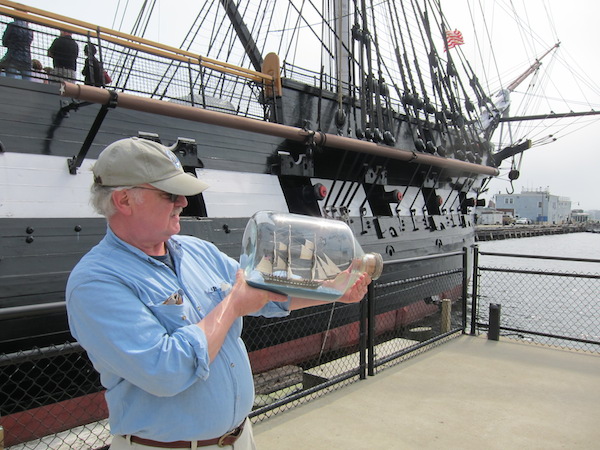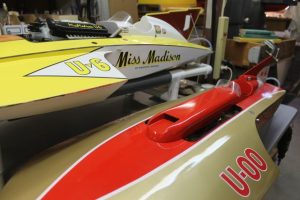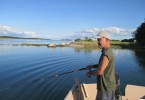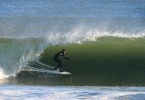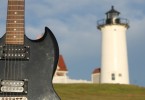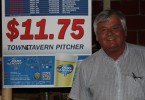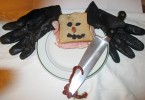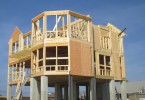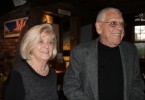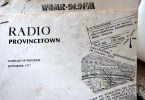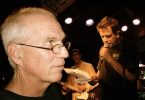
COURTESY OF WOODS HOLE MUSEUM
Sailing in Woods Hole’s Eel Pond is a model of the “Charles W. Morgan,”America’s last whaling ship, was built by modeler Bill Huizing of New Jersey.
WOODS HOLE – Model boat builders have a saying. The hobby takes the patience of a saint, the hands of a surgeon, the eye of an eagle and the ability to swear like a sailor.
That’s according to Alan Lunn of Sippewissett, a boat builder who also builds models.
Lunn, 86, said historical detail is a critical part of model boatbuilding. Model builders like Lunn, who builds from scratch, use plans from the actual boat but then they have to do further research on details. Getting those details right is a point of pride.
“This model building has taken me down some strange streets looking for details,” Lunn said.
Lunn is among the dozens of model ship builders who will be on hand at the Woods Hole Model Boat Show on April 18 and 19.
The biennial event, which is in its tenth year, takes over the village of Woods Hole, filling seven separate buildings with models, exhibits and displays. Among the high points of the show are model boat races in Eel Pond. The show takes place Saturday, April 18 from 9 a.m. to 4 p.m. and Sunday, April 19 from 9 a.m. to 3 p.m.
(To see a slideshow of what’s happening at this year’s Woods Hole Model Boat Show, click here.)
Jennifer Gaines, executive director of the Woods Hole Historical Museum, which puts on the show, said it started with an idea by the late Paul Ferris Smith, a founder of the museum and a boat enthusiast.
Smith had built a few models himself and those will be on display at the show among dozens of others brought by more than 50 model boat builders from throughout the region.
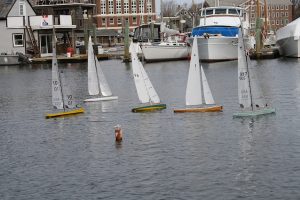
COURTESY OF WOODS HOLE HISTORICAL MUSEUM
Model boats race in Woods Hole during the Woods Hole Model Boat Show.
Gaines explained that there are three major types of boat models: static models, which do not go in the water; pond models, which can sail in the water but do not have electricity and are controlled by using a long stick; and radio-controlled models, which can sail in the water and are powered and controlled by electricity.
All three types will be at the show. There will also be an opportunity for children to build and sail their own model boats, as well as special presentations and exhibits about model boat building. A dock sale, where people can purchase materials for model boat building, is taking place on Saturday and Sunday at three different locations in the village.
Gaines said over the years of the show, she has grown to love it.
From the modelers who make boats from scratch, which Gaines called “astonishingly difficult,” to the modelers who make ships in bottles, Gaines said, “they’re all incredible.”
Lunn, who grew up in Woods Hole, has done a number of models of historic vessels significant to this area that he’ll be bringing to the show, including a 50-pound model of the British brig, the Nimrod, which attacked Falmouth by cannon fire during the War of 1812.
“I had to make 18 cannons on a lath. I thought I’d be making cannons the rest of my life on that one,” Lunn said.
Lunn has also made a model of early explorer Bartholomew Gosnold’s “The Concord,” the boat that is said to have been the first European vessel to discover Cape Cod and Martha’s Vineyard.
A current project of Lunn’s illustrates that a boat modeler’s work is never done.
A friend of Lunn’s, a retired Coast Guard captain, has commissioned him to make models of every ship he served on. So far, Lunn is seven ships into a job with no clear end in sight.
Alex Bellinger said he could have been a skydiver or perhaps a cardiosurgeon or maybe a famous politician. But instead he became a ship model builder.
“I put it down to bad luck,” he said.
Bellinger is among the modelers who will be in Woods Hole with his ships in bottles. Model boat building, he said, is a craft he first began at age 4 when his grandmother was taking care of him and was seeking to amuse him with activities. “First we made paper boats. Then we made them with stuff we found around the house, popsicle sticks and toothpicks,” Bellinger said.
He kept at it, eventually, at age 12, advancing to making ships in bottles. “I was living on a farm and the farmer’s daughter gave me a woodworking book for Christmas and she put a ribbon in the chapter on making ships in bottles,” he said.
Now 64 and living in Newburyport, Bellinger has been at it ever since, making more and more elaborate ships over time.
According to Bellinger, there are four techniques to building ships in bottles: the western method, Japanese technique, modernist technique and dry stick.
He uses with the first two, the western method where the ship is made in a collapsible fashion outside the bottle, then put in the bottle and made upright by the pull of a string.
The Japanese method is a variation in which the ship is sailing away from the neck of the bottle and uses a variation in construction.
The modernist method involves constructing the ship and rigging while it is inside the bottle using handmade tools. Dry stick is a variation on modernist where pieces are laid in the bottle, constructing from the far end of the bottle and working toward the neck, Bellinger said.
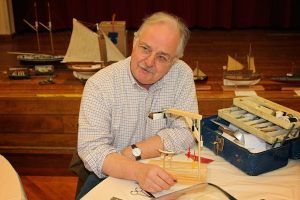
COURTESY ALEX BELLINGER
Alex Bellinger,who will bring his ships in bottles to the Woods Hole Model Boat Show, at a demonstration at the Peabody Ship Model Show.
Bellinger’s favorite vessel that he has constructed is a fishing schooner out of Gloucester that wrecked in 1936 called the Ingomar. He has built it 15 or 16 times.
“It was her lines. her whole shape. It was a nice balance of rigging and hull design. Kind of the embodiment of a good fishing schooner. Kind of a classic New England fishing vessel,” he said.
Bellinger makes all his boats from scratch. He has only used a kit once, when reviewing one for a magazine.
His materials are, as he puts it, “humble stuff: pine or cedar for the hulls, bamboo is best for the mast and spars, good sewing thread, fittings line, paper sails, glazing putty and a good clean bottle.”
He’ll be bringing 11 models to Woods Hole and he looks forward to seeing other modelers there.
The ones who build ships in bottles have a few things in common, Bellinger said.
“Mostly they’ve put a lot of time into it. It’s not the kind of thing you learn over night. Most of them started young,” he said.
Pete Beckloff will also be at the Woods Hole Model Boat Show.
Beckloff, who is 72 and lives in Hyannis, used to build airplanes, full size biplanes that he would fly around Hyannis. He started building full-size boats when he was 15 years old. But about 30 years ago, he started building model boats and he’s been at it ever since.
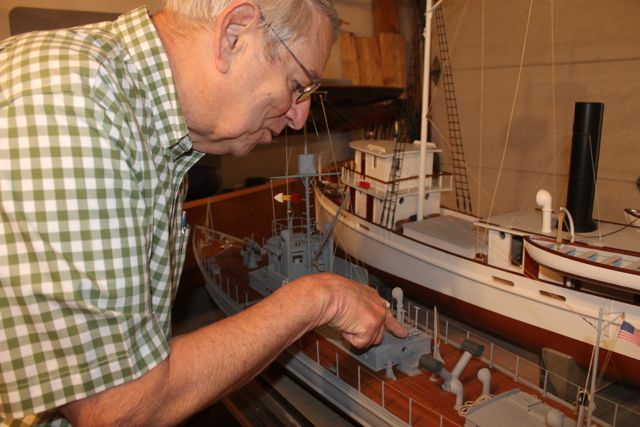
Pete Beckloff points out details in the World War I-era sub chaser he built at 1/24 the size of the original.
To get to Beckloff’s collection of model boats, it’s necessary to walk around his 1915 Model T Speedster.
“I have more than one hobby,” he said, by way of explanation.
He’ll be bringing two World War I era models down to the show, a menhaden fishing steamer and a submarine chaser.
Before retiring, Beckloff owned a company in Sandwich in which he designed and built robotics machinery.
Building things, he said, “that’s all I’ve ever done.”
Beckloff’s boats are all radio-controlled. He lifts a panel in the mid-section of the sub chaser to reveal the engine.
For his boats, Beckloff purchased a fiberglass hull and built everything else from scratch, using pine for the decks, light plywood for the cabins, some spruce for other details.
Once it is complete, the years of effort are worth it, he said.
He does it, he said, pointing to the sub chaser, “just for the satisfaction of making something that turns out like this.”
When he built the sub chaser, he was still at his job, so he worked on it nights and weekends from 1987 to 1996. It is a 1/24 scale model of a 110-foot ship.
Because details are so important to model boat builders, the Internet has been an enormous resource.
For the sub chaser, for instance, Beckloff could not at first find good photos of what the ship’s guns looked like. He eventually found an image online.
He also needed to research what the depth charger looked like. He also found that image on a special website devoted to World War I submarine chargers.
“I like figuring things out,” he said.
Every detail has a story. He pointed out the line ringing the deck. “A lot of people use string, but it’s cable,” he said. He used wire from a model airplane.
“You scrounge around for parts to reuse,” he said.
The menhaden fishing steamer, also World War I era, weighs 40 pounds. Like the sub chaser, it is also built to 1/24 scale.
The steam-powered vessels were used in the Delaware area.
“I really liked that thing. I lived on the Great Lakes. I liked the layout of the boat,” he said.
He built the boat after retiring and kept track of his hours. “I spent 1,000 hours on it,” he said.
Part of model boat building is figuring out how to replicate parts, which is tied into the other big part: research. Building a boat is also a history lesson.
Beckloff’s eyes light up as he talks about the boat, how the fishermen would use an enormous net and men would climb aboard row boats to gather the net and bring in the fish, piling the fish on the deck. Some would pile the fish so high, it would sink the boat.
People who lived in Delaware used to say, when the menhaden boats came in, you could smell the fish a couple towns over. That’s what Beckloff heard.
Fred Abbe of Cataumet will also be at the show. Abbe’s model ship piece de resistance, as his wife Sue puts it, is “When and If,” which was built for General Patton after World War II to use to sail around the world. The boat was built in Vineyard Haven and Woods Hole.
Abbe created the boat using plans from the actual boat and was even able to go aboard the actual boat, which is still kept on the Vineyard, in order to study the details.
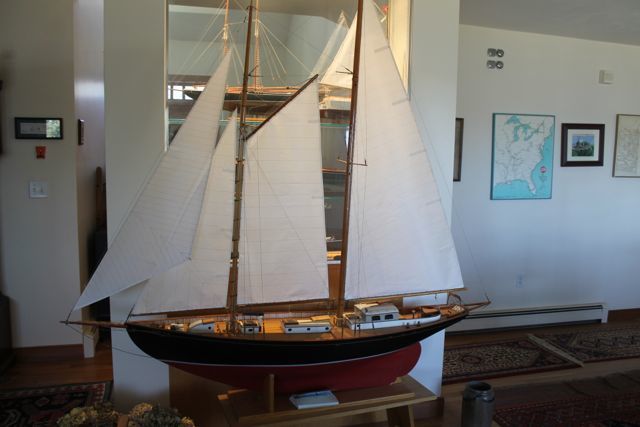
Model boat builder Fred Abbe of Cataumet built the “When and If,” after extensive research, including spending time on the actual vessel.
“It was a one-man obsession,” Sue Abbe said of her husband’s four-year quest to built the model.
The couple worked together to construct the steamboat, the Nellie G., which ferries passengers between Boothbay Harbor and Squirrel Island in Maine.
Sue picked the boat because of her fond memories of summers in Maine and riding on the actual Nellie G.
Fred Abbe, who is 77, said he first got started with model boat building when he was about 12 years old when his mother brought him some antique copies of Rudder Magazine from about 1895. “There were some plans in there,” he said.
He was already into building model airplanes. But he started getting interested in building model boats.
But it was years before he really got into the hobby in earnest. “I didn’t really get serious until I retired,” he said.

Fred Abbe of Cataumet got into building models as a child but got serious about it after retirement.
The Abbes will be bringing a large model of the “Charles W. Morgan” to the Woods Hole Model Boat Show. The “Charles W. Morgan,” built in 1841, is considered the last of the American whaling fleet. It is currently being restored at the Mystic Seaport Museum. The Abbes are storing the model boat for the modeler, Bill Huizing of New Jersey, who painstakingly recreated the boat’s every detail.
In discussing the hobby of model boat building with a number of master crafters, a few qualities appear again and again. Woodworking skills are a must. Problem-solving seems to be a requirement too. Fortitude appears to play a role, since some of these vessels are years in the making. And don’t forget, the ability to swear like a sailor.
– Please like us on Facebook.

